Small Aquariums – Interesting Additions
Freshwater tropical fish wholesale for aquariums as small as 5 gallons can still create very interesting and diverse displays.
Very small delicate fish get lost, or are often eaten by larger fish in a normal sized aquarium (30-125 gallons.) But, in a small 5-10 gallon tank, sitting on an office desk, there really are a large variety of small freshwater tropical fish and invertebrates that can be added to make a display that’s every bit as interesting and aesthetic as a big tank.
Here are some interesting freshwater tropical fish wholesale additions for the smaller tanks. Most do well in a planted tank.
Fork Tail Rainbows – Popondichthys furcata (Indonesia code 4764) average 1”
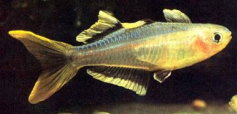
Fork Tail Rainbow
The rainbowfish found in river systems east of the Great Dividing Range of Queensland Australia are schooling and do not do well or show off their best colors if kept singly. Your freshwater tropical fish wholesale tank should include at least six individuals from the species. The tank can be well planted along the back and sides, but leave plenty of open area as these fish are lively swimmers and require lots of swimming room. Use drift wood and bog roots only sparingly as they tend to Acidify the water. A good plant to use is the Java moss as it is native to the region and can also serve as a spawning medium.
Cockatoo Dwarf Cichlid – Apistogramma cacatuoides (Indonesia code 4003) Average 1-1.25”
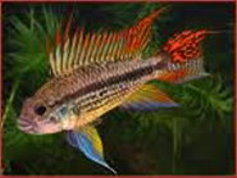
Cockatoo Dwarf Cichlid
Apistogramma cacatuoides is a species of South American cichlid fish usually known under the common name cockatoo dwarf cichlid. The cockatoo dwarf is one of the best suited cichlid species for the planted aquarium. As the male is highly territorial however, its should be kept in pairs, trios (1 male, 2 females) or harems (1 male with many females), and in the company of peaceful tank mates like tetras. Water conditions should be in the pH6.0-pH7.5 range.
Agassiz’s dwarf cichlid – Apistogramma agassizii (Indonesia code 4688) Average 1-1.25”
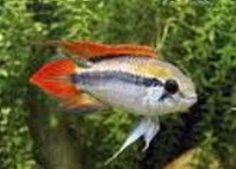
Agassizi’s Dwarf Cichlid
Apistogramma agassizii is the scientific name for the Agassiz’s dwarf cichlid, a fish that occurs in many Southern tributaries of theAmazon river. Male Agassiz’s dwarf cichlids are territorial by nature. Just like all dwarf cichlids the Agassiz’s dwarf cichlid requires weekly partial water changes in order to keep the nitrate levels as low as possible. The Agassiz’s dwarf cichlid grows to 4 inches (10 cm.) in length. It prefers a hardness level of 50–10 m/gl and a pH of 6.0.
Apistogramma pandurini (Indonesia code 4240) Average 1-1.25”
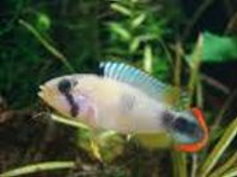
Apistogramma pandurini
A freshwater fish from South America. It is a dwarf cichlid, closely related to Apistogramma nijsseni.
Apistogramma Panduro, are sometimes referred to as Apistogramma pandurini. The name is derived from the Peruvian fish exporters who first collected the fish. Their native Peruvian waters are soft and acid with a sandy substrate. pH in their native waters is usually below 6.0. They are not fussy eaters and will adapt to most high quality foods.
Blue Killifish – Aphyosemion gardneri (Indonesia code 4629) Average 1.25”
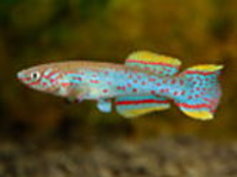
Blue Killifish
A killifish is any of various egg-laying cyprinodontiform fish. All in all there are some 1270 different species of killifish, the biggest family being Rivulidae, containing more than 320 species. Members of this order are notable for inhabiting harsh environments, such as saline or very warm waters, water of poor quality, or isolated situations where no other types of fish occur. They are typically omnivores, and often live near the surface, where the oxygen-rich water compensates for environmental disadvantages.
Clown Killifish – Epiplathys annulatus (Indonesia code 4186) Average 1.25”
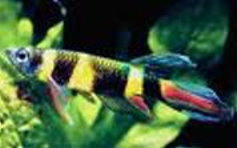
Clown Killifish
The Clown killi or Banded panchax is a type of killifish, and is not related to a clownfish. It is a rather rare fish and is marked with brown and yellow with vivid blue and red.
Most Killifish are territorial to varying degrees. In the aquarium, territorial behavior is different for every grouping, and will even vary by individuals. In a large enough freshwater tropical fish wholesale aquarium, most species can live in groups as long as there are more than three males.
Pencilfish – Nannostomus beckfordi (Indonesia code 4663) Average 1 -1.25”
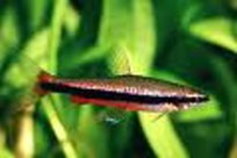
Pencilfish
Nannostomus thrive in home aquaria when provided with soft, moderately acidic water, low nitrate levels and temperatures in the range of 72F to 82F. The addition of aquatic plants, including floating varieties, is recommended. The latter will reduce the likelihood of the fish jumping, which is a common occurrence for some of the species, especially N. espei and N. unifasciatus. They should be kept in schools of at least six in a freshwater tropical fish wholesale tank.
If kept in a community aquarium, the best tank mates are other species of Nannostomus, small peaceful characins andcorydoras. Aquaria with strong water current, large tank mates, or swift-moving species are contraindicated. If kept in a thickly planted single-species aquarium with the above water parameters, most species will spawn, eggs will not be eaten, and the fry will be found among the floating plants. Baby brine shrimp, live or frozen, and other small-sized foods are required for both fry and adults.
Nannostomus are also avid biofilm grazers and, for most of the species, algae is an under-reported staple of their diet. In most species the males will establish small territories and defend them. Their defensive actions are usually harmless but, in two species, N. mortenthaleri and N. trifasciatus, antagonistic behavior directed atconspecifics can have deleterious results if sufficient space and plant cover are not provided. Once acclimated to the aquarium, and provided with conditions to their liking, Nannostomusare hardy and have a firm grasp on life, often living for five or more years.
Threadfin Rainbow – Iriatherina werneri (Indonesian code 4650) Average 1.25 – 1.5”
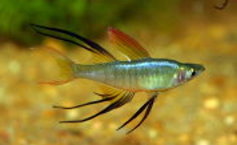
Threadfin Rainbow
The threadfin rainbowfish or featherfin rainbowfish: In aquaria they are usually peaceful, they live preferably in groups of six or more. Because of their long fins they should obviously be kept in a tank without fin-nippers. They breed best in tanks without other species.
Threadfin Rainbowfish do well in aquariums of 20 US gallons (76 L), however 30 US gallons (110 L) is preferred. They are best housed in a “species only” tank; meaning that the tank is reserved for the Threadfins alone. Because of their tiny mouths, they can be difficult to feed. They do well with live foods, such as baby brine shrimp, and the micrometre larval diets. They prefer water that is soft to moderately hard, slightly acidic (pH 6.0–7.0), and with a temperature of 23–29 °C (73–84 °F).
Marble Hatchet fish – Carnegiella strigata (Brazil Code 6117) Average .75 – 1”
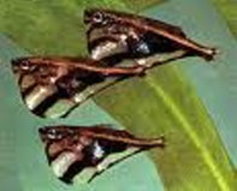
Marble Hatchet fish
The Marbled Hatchet fish, is a small, freshwater ray-finned fish native to South America and is common in the aquarium industry. Like most Amazonian fish, the species prefers softer, acidic water. Hatchets usually occupy the top portion of the freshwater tropical fish wholesale tank and like many other aquarium species may be shy at feeding times just after they have been introduced. However, given some time and proper water conditions, they will be less hasty.
As with most Characins (see Characidae), they areomnivores and prefer a varied diet, including live or frozen food, and vegetables. However, they will not swim to the bottom to eat so all food must float. Hatchets have a tendency to be shy fish and are easily intimidated by larger or fast moving fish, so they are only appropriate for very peaceful communities or species tanks.
They will also be happier if they don’t have to share the top portion of the tank with any other fish and if kept in schools of at least three. They like plants with long trailing leaves to hide under. It is absolutely necessary for tanks inhabited by these beautiful fish to have a tight lid, as they can and will jump when startled.
Cardinal Tetra – Paracheirodon axelrodi (Brazil Code 6102) Average .5” – 1”
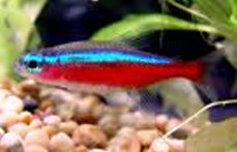
Cardinal Tetra
The cardinal tetra, is a freshwater fish native to the upper Orinoco and Negro Rivers in South America. Given the origins of the cardinal tetra, namely blackwater rivers whose chemistry is characterised by an acidic pH, low mineral contentand the presence of humic acids, the species is adaptable to a wide range of conditions in captivity, though deviation from the soft, acidic water chemistry of their native range will impact severely upon breeding and fecundity.
The preferred temperature range of the fish is 21°C to 28°C (70°F to 82°F). The water chemistry of the aquarium water should match that of the wild habitat – filtration of the aquarium water over peat is one means of achieving this.
Scarlet Gem Badis – (Singapore code 1863) Average 1”
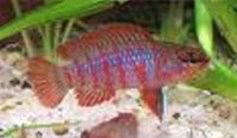
Scarlet Gem Badis
The Badis is a small, predatory fish that feeds on tiny invertebrates. Males normally display stronger coloration and females may appear more rounded when gravid. Coloration is extremely variable and changes with mood, though typically the fins are blue and dark vertical bands are apparent on the flanks.
Galaxy Rasbora – Celestichthys Margaritatus (Singapore code 2153) Average 1”
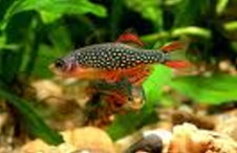
Galaxy Rasbora – Danio
Danio are native to the fresh water rivers and streams of Southeast Asia, The Danio is an ideal species for any planted or community aquarium as theyt adds color and will get along with other community species well. They are quite easy to care for as they will tolerate a variety of water temperatures and conditions, although they would prefer a water temperature around 78° F with a slightly alkaline pH.
Danio are a small schooling species that should be kept in groups of at least 6 individuals with 8 or 10 individuals in the group being ideal. It is best to duplicate their natural environment in the freshwater tropical fish wholesale aquarium with an abundance of live plants and with some drift wood and rocks. In the wild this species lives in very calm water that is often spring fed or formed from overflows of other waterways, thus they should be kept in aquariums that do not have constant strong direct currents. They live in shallow water in the wild that has strong direct sunlight, so they do very well in strongly lit planted aquariums, and will use heavily planted areas in the aquarium or driftwood and rocks to retreat to if they feel threatened.
The Celestial Pearl Danio is an omnivore that will eat virtually any standard topical fish foods available within the hobby. They will readily accept flaked foods, frozen preparations, vegetable or algae flakes and wafers along with freeze-dried bloodworms, tubifex worms and brine shrimp. Essentially they will eat the same foods that would be being fed to the bulk of tropical freshwater species found in a tropical community aquarium.
Harlequin Rasbora – heteromorpha (Singapore code 2159) Average .75”
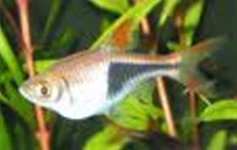
Harlequin Rasbora
All of the Rasbora species are unaggressive, peaceful, and can be kept with fish of similar temperament. They are strong swimmers and in nature prefer to be in small schools. They like to stay in the upper areas of the freshwater tropical fish wholesale aquarium. Your tank should provide plenty of open space for swimming as well as some dense plantings to serve as shelter. The water temperature should be kept around 76f. Rasboras prefer soft water and if possible you should use a peat filter bag in your filter, (Tetras will benefit also.) They will eat flake, frozen as well live food.
Many species of Rasbora will breed without too much difficulty, spawning freely in soft, neutral or slightly Acidic water. Unfortunately Rasbora Heteromorpha is not one of these. The water should be very soft with a hardness of 1.5 to 2.5 DH and a Ph of around 6.0.
For information on ordering these freshwater tropical fish wholesale for your pet store, call East Coast Tranship, Inc. at 301-782-1025.
Many freshwater tropical shrimps wholesale add color and interest to small aquariums:
Red Crystal Shrimp (Indonesia code 4450) Average .5” – 1”
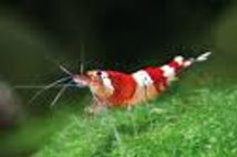
Red Crystal Shrimp
Most shrimp varieties have a relatively large tolerance range with regard to water values. A good supply of oxygen is particularly important. If the oxygen level drops too low, this will have an adverse effect on their health.
Many varieties thrive at a room temperature of 20-22 °C. Tropical varieties prefer slightly warmer temperatures, in some instances up to 28 °C. In this case an additional heater is necessary, such as the Nano adjustable heater. Shrimps will become inactive if the water is too cold.
Plenty of hiding places, such as densely planted, shaded areas, foliage, and above all cave-like retreats, are of great importance to their well-being.
Celebes Beauty Shrimp (Indonesia Code 4244) Average .5”+
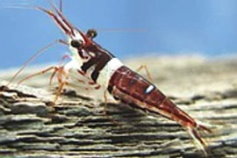
Celebes Beauty Shrimp
Shrimps are generally omnivores, with a special preference for vegetable-based foods. In addition to algae, their natural diet also includes animal plankton, detritus (dead vegetable matter, rotting foliage, etc.) and even carrion.
These natural source of nutrition are usually lacking in an aquarium. Different types of frozen feed (midge larvae, artemia) fresh vegetables (spinach, courgettes) or herbs (stinging nettles) should be added to the diet on a regular basis as supplements and to provide a touch of variety.
White Spot Shrimp (Indonesia Code 4243) Average .5”+
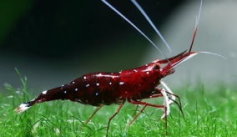
White Spot Shrimp
The White Spot shrimp (fire shrimp) is considered one of the most attractive fresh water shrimps belonging to the Caridina genus. As a rock dweller it spends most of its life between and under the rocks. Their native lake environment has a high water quality, clear and with low nutrient content. The water values do not fluctuate to any substantial degree. Requirements: temperature 27-29 °C; PH: 7.4 – 7.8
Red Cherry Shrimp
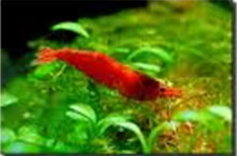
Red Cherry Shrimp
(Indonesia Code 4246) Average .5” – .75”
The Red Cherry Shrimp is an undemanding shrimp in its care requirements. They should be kept in a well established freshwater tropical fish wholesale aquarium with no predators. The most important factor for water parameter is stability and as long as none of the water parameters are in the extremes Red Cherry Shrimp should be happy and healthy.
This shrimp is an Omnivore, and They are decent algae eaters. If sufficient algae is not present foods intended for aquarium fish and invertebrates can be used to supplement their diet. Another great supplement is blanched (boiled until soft) vegetables
Blue Bee Shrimp (Indonesia Code 4439) Average 1”
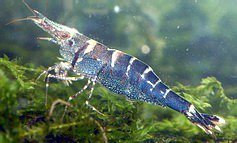
Blue Bee Shrimp
The Blue Bee Shrimp is relatively new to the shrimp hobby. It was first introduced around March 2008. It can be many colors and is sometimes hard to obtain due to the fact that it is wild caught and just starting to be bred by hobbyists.
The Blue Bee Shrimp is a wild caught species found in freshwater streams in China. So far virtually all of the Blue Bee Shrimp in the hobby are from the wild. Breeding has begun however and captive bred specimens should not take long to hit the hobby shelves.
Successful breeding has been reported in a pH range of 6.5 to 6.8 with a temperature of 74F. These parameters are very similar to the parameters required for the Crystal Red Shrimp or Bee Shrimp. Since this is a close relative of those two species I suspect that the same care should be given to the Blue Bee.
Feeding is best done once a day. Only feed an amount of food that the shrimp can finish within 2-3 hours maximum. It is not good to feed in excess and have food sitting for too long. Overfeeding is a known cause of death and can also cause water quality issues. Since shrimp are scavengers in the wild, they will eat whatever they find and are not used to a constant food source.
Black Crystal Shrimp (Indonesia Code 4437) Average .5” – 1”
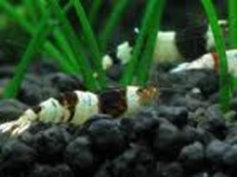
Black Crystal Shrimp
This is a black color morph of the Bee Shrimp, established in 1991, it may referred to as the Crystal Black Shrimp or CBS. It is exactly the same as the Bee Shrimp but is now being bred separately for the color. This genetic mutation was discovered in Japan in 1996 and was registered as a trademark in that country.
Like all crustaceans, shrimps continue to grow throughout their lives. They molt at regular intervals, in order to discard their old shells which have become too small for them. As the body is very soft and extremely vulnerable during molting, they withdraw to the safety of a hideout. After a few days the new shell has hardened and the shrimps return to their normal lives.
East Coast Tranship, Inc. is a freshwater tropical fish wholesale supplier that sells to the pet store trade only. We are a direct importer which means you save 50 to 70% over wholesale prices.
To ask questions or place orders call 301-782-1025
To request price lists, visit Price List
To apply for a company check account download this application
For more information watch this video
Small Aquariums – Interesting Additions

Leave a Reply